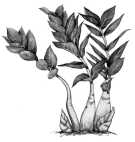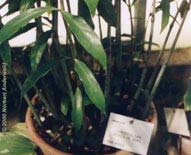Etymology

|
The name Zamioculcas derives from Zamia (a genus of the cycad family Zamiaceae) and qolqas (Arabic for taro, i.e. the tropical crop Colocasia esculenta. The name of this aroid genus, Colocasia, contains the same stem).
The reference to Zamia relates to a certain similarity with the pinnate leaves of some members of this Cycad genus that have dark green, ± xeromorph leaflets with a shape reminding of those of Zz. This superficial resemblance is repeated in the epithet zamiifolia (=with Zamia's leaves).
Regardless of floral differences (Zamioculcas is a monocot angiosperm, Zamia is a cycad gymnosperm), Zamia -like virtually all Cycads- has a rosette of leaves on top of a normally monopodious wooden stem (and not alternate leaves from a tuberous underground rhizome like Zz); Zamia's leaflets are parallel-veined (Zz: reticulate), and no Cycad has either the quite conspicuous inflated leaf bases or the 'knee' in the leaf petiole of Zamioculcas.
According to IPNI (International Plant Names Index), the epithets zamiifolium, zamiaefolia, or zamioides are also found in the following (mostly outdated) combinations (results © the Plant Names Project, quoted in full):
Alstroemeriaceae: Alstroemeria zamioides Baker
in: Journ. Bot. xv. (1877) 262.
Original Data: Notes: Bras
Aspleniaceae: Asplenium zamiifolium Willd.
in: Species Plantarum ed. 4, 5(1) (25-27 Jan. 1810) 325.
Type: As Text: "Habitat in umbrosis ad Caracas ... Brodemeyer."
Balanophoraceae: Ombrophytum zamioides Wedd.
in: Ann. Sc. Nat. Ser. III. xiv. (1850) 184. t. 10.
Original Data: Notes: Peruv
Coniferae: Podocarpus zamiaefolia A.Rich.
in: Ess. Fl. N. Zel. 360.
Original Data: Notes: =Dammara australis
Coniferae: Podocarpus zamiaefolia Hort. ex Carr.
in: Conif. ed. I. 441.
Original Data: Notes: =latifolia
|
An english vernacular name for Zamioculcas is "Aroid Palm"; however, Zz is not a tree (it does not even have a wooden stem), which is a very distinctive character of (most) palms. (After all, you wouldn't call a fern or a member of the Apiaceae a "palm", only because it has pinnate leaves, would you?)
The (quasi) common English name "Zz plant" has no connection with "ZZ Top" (a music group), but is, of course, an abbreviation of the scientific name. (Annotation: ;-)
|
Images of some species of Zamia:
Zamia pumila
© James Manhart
Zamia furfuracea
© www.cycad.org
Zamia fischeri
Zamia loddigesii
© Hugh Wilson |

